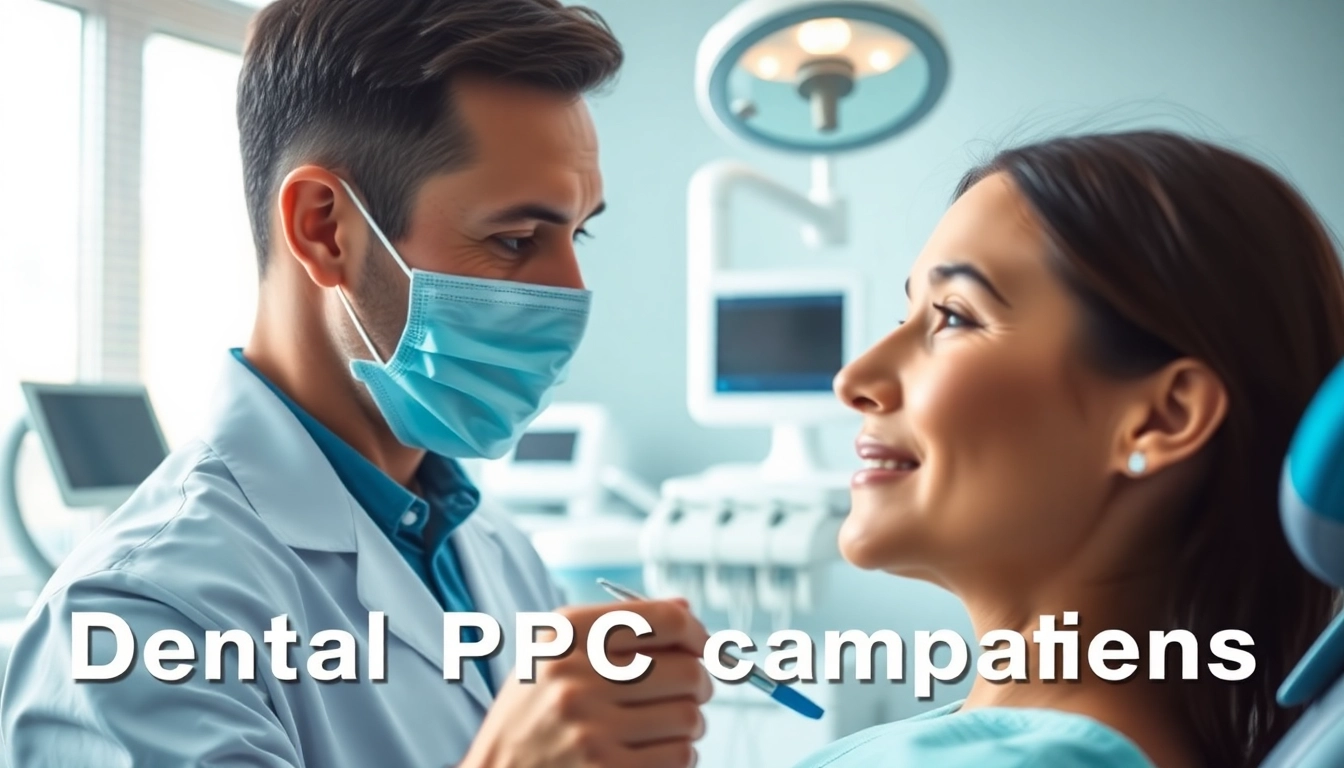Understanding Dental PPC and Its Importance
In an increasingly competitive healthcare landscape, dental practices must adopt innovative marketing strategies to attract and retain patients. One potent method at their disposal is Dental PPC (Pay-Per-Click) advertising. This digital marketing approach allows practices to display targeted ads prominently in search engine results, capturing the attention of potential customers at the moment they are looking for dental services. Understanding the intricacies of Dental PPC can drastically transform patient acquisition strategies, driving growth and enhancing practice visibility.
What is Dental PPC?
Dental PPC is a type of online advertising wherein dental practices pay a fee each time their ad is clicked. This model ensures that dental providers only incur costs when a user shows interest in their services, making it a cost-effective marketing solution. Typically facilitated through platforms such as Google Ads and social media networks, Dental PPC enables practices to appear at the top of search results for relevant keywords, thereby enhancing visibility.
Benefits of Dental PPC for Practices
The advantages of implementing Dental PPC campaigns in a dental practice are numerous:
- Instant Visibility: Unlike organic marketing strategies, which can take time to yield results, PPC campaigns allow dental practices to achieve immediate visibility in search results.
- Targeted Advertising: Dental PPC enables practices to target specific demographics, locations, and search patterns. This targeting minimizes the likelihood of spending on ads that do not reach the intended audience.
- Measurable ROI: Through various analytics tools, practices can track the effectiveness of their PPC campaigns in real-time. This enables adjustments based on performance, optimizing spending and enhancing ROI.
- Budget Control: Dental practices can manage their ad spend by setting daily budgets, ensuring they do not overspend while maximizing their advertising reach.
- Competitive Edge: Engaging in PPC advertising allows dental practices to compete effectively against other local providers, ensuring they capture their share of the potential patient base.
Common Misconceptions about Dental PPC
Despite the highlighted benefits, several misconceptions about Dental PPC persist:
- “PPC is only for large practices.” In reality, even small or new dental practices can benefit considerably from PPC advertising, provided they have a clear understanding of their target market.
- “PPC is too expensive.” While costs can add up, the strategic implementation of campaigns focused on high-converting keywords can lead to profitable returns that far outweigh initial expenditures.
- “Organic SEO is better than PPC.” Each strategy has its merits. While SEO is essential for long-term growth, PPC can provide instant results that boost traffic and drive conversions faster.
Setting Up a Dental PPC Campaign
Setting up an effective Dental PPC campaign requires strategic planning and execution. By following a structured approach, practices can create ads that resonate with potential patients.
Identifying Target Audiences for Dental PPC
Successful Dental PPC campaigns begin with defining and identifying target audiences. This involves understanding demographic information such as age, location, income level, and specific dental needs.
Utilizing tools like Google Analytics can help practices gather demographic insights about their existing patient base, enabling them to build profiles of potential new patients. Factors to consider include:
- Geolocation: Since dental practices rely on local clientele, targeting specific zip codes or neighborhoods can yield better results.
- Age Group: Different dental services appeal to various age groups, thus tailoring ads to address the needs of specific segments can increase engagement.
- Interests and Behaviors: Understanding patient interests—such as cosmetic dentistry or orthodontics—can help shape ad messaging.
Choosing the Right Keywords for Your Dental PPC
Keyword selection is crucial in determining the success of a Dental PPC campaign. Keywords should be relevant, specific, and reflective of patients’ search queries. Exploring tools like Google Keyword Planner can help practices identify high-traffic keywords tailor-suited for their services.
Considerations for effective keyword selection include:
- Long-Tail Keywords: These are more specific phrases that often attract fewer searches but generally convert better since they cater to niche needs. For instance, “pediatric dentist near me” vs. “dentist.”
- Competitive Analysis: Research competitors’ ads to understand which keywords they are targeting, providing insight into what works within the industry.
- Negative Keywords: Identify negative keywords that are irrelevant or associated with undesired traffic to prevent wasted ad spend.
Crafting Compelling Ad Copy and Design
Once the audience and keywords are established, creating compelling ad copy and design is paramount. Effective ad copy should be concise, engaging, and include a strong call-to-action (CTA) that encourages potential patients to click through. Here are tips for crafting effective ad copy:
- Highlight Unique Selling Propositions: Emphasize what sets your practice apart, such as accepted insurance plans, unique treatments, or special promotions.
- Use Action-Oriented Language: Phrases like “Schedule Your Appointment Today” or “Get 20% Off Your First Visit” can prompt immediate action.
- A/B Testing: Regularly test different ad versions to evaluate which headlines and CTAs generate the highest click-through rates.
Optimizing Dental PPC Performance
Optimizing a Dental PPC campaign is an ongoing process that involves careful monitoring, measuring, and adjusting strategies based on performance metrics.
Tracking and Analyzing PPC Metrics
Monitoring essential metrics is necessary to gauge the effectiveness of a PPC campaign. Key performance indicators (KPIs) to track include:
- Click-Through Rate (CTR): Indicates how often people click on ads when they appear in search results. A higher CTR suggests that the ad is relevant and engaging.
- Conversion Rate: Measures the percentage of clicks that lead to desired actions, such as appointment bookings. Tracking conversions helps determine the effectiveness of campaigns.
- Cost Per Click (CPC): The amount spent on advertising divided by the number of clicks. Monitoring CPC helps practices assess the cost-effectiveness of their campaigns.
Adjusting Bids and Budgets for Maximum Impact
Managing bids and budgets is crucial for maximizing the impact of Dental PPC campaigns. Regular review and adjustments can ensure that spending aligns with campaign performance:
- Set Competitive Bids: Continuously analyze competitor behavior to adjust bidding strategies in real time based on market conditions.
- Redistribute Budgets: Free up funds from underperforming areas by redirecting them toward high-performing keywords or locations.
- Monitor Scheduling: Analyze performance data to determine which days and times yield the best results, and adjust ad scheduling accordingly.
A/B Testing Strategies for Dental PPC Ads
A/B testing is a powerful method for optimizing ad performance by comparing two versions of an ad to see which one performs better. Here are some strategies to implement:
- Test Different Messaging: Vary headlines, descriptions, and CTAs to find out what resonates best with your audience.
- Design Variations: Experiment with different visual elements, including images, ad formats, and layouts, to discover what attracts more clicks.
- Landing Page Testing: Ensure that the landing page is aligned with the ad messaging, providing a seamless transition for users that encourages further engagement.
Advanced Dental PPC Techniques
Once foundational strategies are in place, practices can adopt advanced techniques to further enhance PPC performance and accelerate patient acquisition.
Utilizing Remarketing Strategies for Dental PPC
Remarketing involves targeting users who have previously interacted with your website or ads but did not convert. This strategy can significantly boost conversion rates by keeping your practice top-of-mind. Establish remarketing campaigns featuring:
- Custom Audience Segments: Create tailored ads for specific segments based on user behavior, such as those who visited the teeth whitening page but did not book an appointment.
- Dynamic Ads: Utilize dynamic ad strategies that automatically generate personalized ads for users based on their previous interactions.
Integrating Dental PPC with Other Marketing Channels
For maximum impact, integrating Dental PPC with other marketing efforts creates a cohesive strategy that enhances visibility and engagement. Strategies to consider include:
- SEO Synergy: Employing SEO strategies alongside PPC can enhance organic click-through rates and bring more visibility to paid ads.
- Social Media Campaigns: Incorporate social media advertising to complement PPC efforts, leveraging organic social to nurture relationship-building with patients.
- Email Marketing: Use remarketing emails to target leads captured through PPC campaigns, providing additional incentives and reminders that nurture leads down the funnel.
Innovative Approaches to Stay Ahead in Dental PPC
Staying current with the latest PPC trends and technologies is essential for maintaining a competitive edge:
- Utilizing AI and Automation: Take advantage of tools that offer automated bidding strategies based on performance data, optimizing spend effectively.
- Video Ads: Consider using video ads on platforms such as YouTube to showcase procedures, introduce staff, or offer virtual tours of the clinic, making the practice more approachable.
- Voice Search Optimization: As voice-activated search grows in popularity, consider how users are likely phrasing their queries and adjust your keywords accordingly.
Measuring Success and ROI of Dental PPC
The ultimate goal of any Dental PPC campaign is to achieve a positive return on investment. Effectively measuring success requires a clear strategy for evaluating key metrics.
Defining Success Metrics for Dental PPC
Establishing clear success metrics can help practices assess the effectiveness of their campaign. Some key metrics include:
- Cost Per Acquisition (CPA): Understanding the cost to acquire a new patient can help practices determine if their spending aligns with patient lifetime value.
- Patient Retention Rate: Tracking the number of patients returning for additional services can indicate the efficacy of ads in attracting long-term patients.
- Overall Revenue Growth: Monitoring changes in overall revenue, as influenced by PPC campaigns, provides insight into the overall financial health of the practice.
Calculating Return on Investment from Dental PPC
To calculate the ROI of a Dental PPC campaign, calculate the total revenue generated from the campaign divided by the total investment made, then multiply by 100 to get a percentage. Understanding this figure can enhance the budgeting and strategy decisions for future campaigns.
Long-Term Impact of Successful Dental PPC Campaigns
Successful Dental PPC campaigns have long-lasting effects that go beyond immediate patient acquisition. Over time, increased visibility can bolster the practice’s reputation, create brand loyalty, and contribute to a steady increase in patient referrals. Furthermore, ongoing engagement with patients—driven through targeted ads and remarketing—can form an integral part of a holistic marketing strategy that lays fertile ground for future growth.



